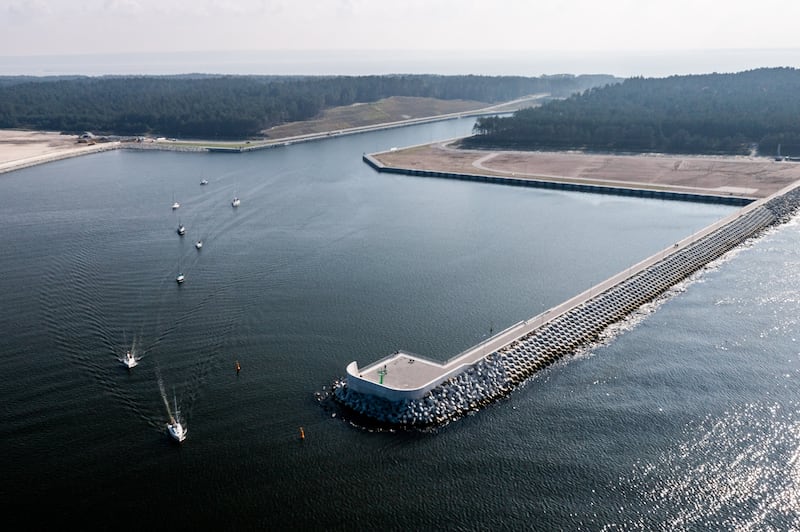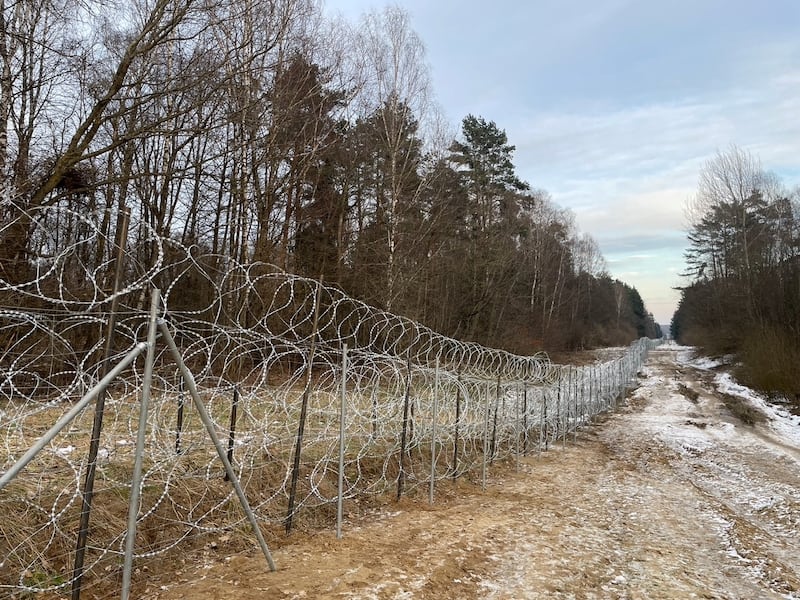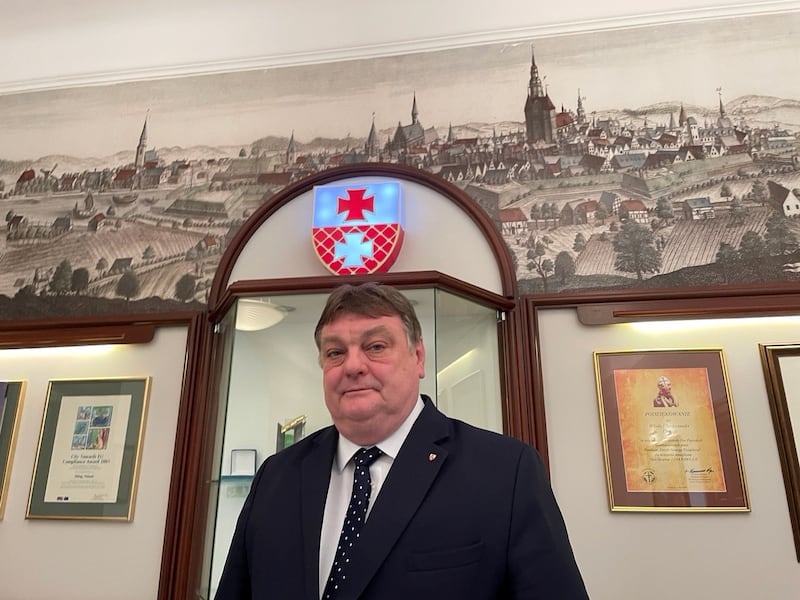Painted blue and white to look like an ocean liner, the Polish port-master building is named Nowy Swiat: new world.
A year into Russia’s invasion of Ukraine, Poland’s own tragic history with Moscow has left it determined, in this brave new world, not to fail its closest neighbour – and not to fail itself.
Some 1.5 million Ukrainians are estimated to have found refuge in Poland, while Warsaw has supplied Kyiv with nearly €2 billion in military aid.
Southwest Poland is a key supply base and training hub for Ukrainian soldiers, while Warsaw plans to boost its military spending budget to twice Nato’s minimum. –.
READ MORE
That’s where the “New World” harbourmaster building comes in. It sits alongside a remarkable new canal, just 1km long and 250m wide, cutting through a sandy land spit to connect the Baltic Sea with the Vistula lagoon behind and the nearby city of Elbląg.
Even on this drizzly winter morning, families have come from all over to admire this new engineering marvel that has redrawn the postwar map.
[ Poland completes second stage of project to seal its border with BelarusOpens in new window ]
In 1945, as victorious Allies shifted Europe’s borders and ethnic groups, Stalin’s Soviet Union took control of the German region of East Prussia and the historic of city of Königsberg. Renamed Kaliningrad Oblast, the Russian exclave is home to one million people, military bases and Russia’s only ice-free Baltic harbour.
After decades in which both were on the same side of the Iron Curtain, Russia’s invasion of Ukraine means Kaliningrad could be a flashpoint if Moscow seeks direct conflict with frontline Nato members.
Many in Poland hope their new 2 billion zloty (€420 million) canal and harbour project gives Moscow one less excuse for war. Begun in 2019 and forecast to be fully operational by year-end, it will allow ships to pass a lock to reach eastern Poland directly. Since 1945, every ship heading this way has had to make a 100km detour – and seek permission to pass Kaliningrad from Russian authorities.
“Russia always thought they could control this area, but not any more,” says Jacek Kościuch, a local Polish harbourmaster official. Staring out at the glinting water, he says the canal was completed despite – or perhaps because of – war-related material shortages and cost spikes. “This canal removes the remnants of cold war in people’s minds and will open this region to the world.”

As Poland opens one door to the western seas, it is closing others to its east, after years of controlled decline. At one time a visa-free travel regime for border region residents on both sides saw six million crossings. Even after Poland suspended the programme in 2015 people kept coming, with three million still crossing in 2019. Of four official border crossings closed in the pandemic, just two reopened, checking just 364,000 people last year.
The checkpoint near the village of Crzechotki is a sprawling complex of steel and glass boxes, built in the 1990s to cope with booming cross-border traffic from commuters and smugglers. On a recent Thursday afternoon it is deserted, with just one white van with a Russian registration crossing into Kaliningrad.
Going off-road in a Polish border guard jeep, we bounce through the countryside of frozen streams and lakes. Behind a line of bare trees and colourful, squat beehives we stop at a new addition to the landscape.

Along the edge of a new corridor cut through the forest, red-and-white painted border posts stand in the middle of silvery razor wire: three spools, stacked on top of each other to create a three-metre barrier.
What was once a 200km open “green” border with Kaliningrad is now a high security dead-end. Border guards here say 30km of the physical barrier has yet to be finished, with sensors and cameras to follow.
Poland has already erected a barrier on its border with Belarus after Minsk began luring asylum seekers from Syria, Afghanistan and elsewhere to its forest border region with promises of easy passage to Poland and the EU. Warsaw pushed back against what it views as part of a Russian hybrid war. It feared a new front would open when Kaliningrad’s Karabrovo Airport announced last October it was working to “attract airlines from countries in the Persian Gulf and Asia”.
The western world doesn’t understand the Russian mentality of might is right
— Elbląg president Witold Wroblewski
Last November, defence minister Mariusz Błaszczak announced plans for a “leakproof” temporary border to Kaliningrad. Inspecting the new razor wire barrier, which looks like it has been built to last, the border guards say they dread having to remove any animals which get trapped in the barrier’s lethal spools.
“It’s because of the Belarus situation that we have this here, we don’t know what will happen in future,” says one guard. “It is quite difficult to cross now, though, if someone wants to cross, with the right tools they will.”
[ Why is Kaliningrad at the centre of a row between Russia and Lithuania?Opens in new window ]
Returning to the jeep, past unused spools of razor wire glinting in the grass, the Polish border guard recalls visiting a schoolfriend in Dublin before the pandemic, now working as a garda. Weekend patrols through Temple Bar seem infinitely more attractive than policing this uncertain geopolitical standoff.
Driving back through the lonely landscape, as the sun sets orange and red, history leaks into the present. Tucked into the landscape, beyond oak-lined country roads, ruined East Prussian homesteads crumble silently as they have done since their terrified German owners fled westward from the approaching Red Army.
A red-starred Soviet war memorial, surrounded by rows of silent soldiers’ graves, lies on the outskirts of the Polish city of Elbląg, rebuilt along historical lines in the last decades after British bombers destroyed it in 1945. Further into town, secondary school students spill on to the street with many wearing the latest fashion: military jackets bearing the red and white Polish stripes.
In his city hall office, Elbląg’s president (mayor), Witold Wroblewski, says his town of 119,000 people has pulled together since Russia invaded Ukraine. Some 1,200 Ukrainians now live here, including 300 children, while the sixth aid transport is on the road. Two town partnerships with the Kaliningrad exclave, meanwhile, are frozen indefinitely.

“People have a bad taste in their mouth when they think of the Russian people, a distaste which didn’t start last year,” he says, alluding to a blood history of invasions, partitions and massacres – by Germans and Russians.
Centuries of uneasy coexistence and eight decades in Kaliningrad’s militarised shadow has created a tradition of alertness in the region, says Wroblewski. During exercises to test Elbląg’s emergency plans and key infrastructure, he says the city’s water supply was attacked by hackers – origin unknown.
“The western world doesn’t understand the Russian mentality of might is right,” says Wroblewski. “Unfortunately the only way to deal with them is to play them at their own game.”
[ Kaliningrad letter: Russia’s Baltic outpost grapples with ghosts of German pastOpens in new window ]
But what is the game Russia is playing with its Baltic neighbours, in particular Poland? Ask locals and you get one common response: Russia is all bark and no bite – at least not since Poland shrugged off the Moscow-steered Warsaw Pact to join the rival Nato alliance in 1999.
As Nato expanded to Poland and the three Baltic countries – former Soviet republics – Russia has upgraded its Kaliningrad facility and reportedly moved in Iskander missiles. Moscow declines to comment in detail about its military arrangements in the exclave, in particular on whether the missiles have a nuclear capability.
Everything points to a world war now, it just fills me with such sadness
— Wodek Mengel
Among the more informed speculators in Elbląg is retired colonel Zbigniew Ruciński. He spent his working life building military airports and worked for long periods inside Kaliningrad. Over coffee and cake, he urges western countries not to overestimate Russian military capacity in the exclave. Though it remains of strategic importance, the Nato accession applications of Finland and Sweden mean things are getting tight for Russia in the Baltic Sea. He dismisses talk of a nuclear capability in Kaliningrad, ready to strike western Europe, as Russian propaganda.
“They wouldn’t put all their reserves there now because they could be surrounded, it’s all about defence in there now, not offence,” he says. After decades working with the Russian army, he is unfazed by the prospect of his country facing it down now: “We’ve known these pr*cks for a long time. If the first attack comes from Russia on Poland, I’ll bring four trucks of vodka to the border and that will be that.”
Home-made quince liquor is on offer in the cheerful livingroom of local man Wodek Mengel. As the light fades, he reflects on a life book-ended by war and sounds a little less stoic than others here in northeastern Poland.
“Everything points to a world war now, it just fills me with such sadness,” he says.
Born in Warsaw in 1935, Wodek’s earliest memory is of queuing with his mother outside a bakery in 1939 as a low-flying Nazi plane strafed the street.
Flicking through old photographs, he explains how his Russian-born parents were forced labourers in Nazi-occupied Austria. An only child, he and his parents rebuilt their lives in the ruins of Elbląg. Like other returnees, they were told to take one of the vacant homes abandoned by fleeing Germans – including furnishings and books.
Still living in the same house claimed by his family in 1945, Wodek heads for the cellar and opens a cupboard. Inside are old volumes of East Prussian history and a pristine black hardback: a 1933 edition of Adolf Hitler’s Mein Kampf.
Perusing a chapter headed “the use of pure violence”, Wodek says he views the Russians – his parents’ people – as “murderers now, nothing more, shooting women and children in the head”.
Putting Mein Kampf back out of sight, he adds: “Putin and Hitler, I think they’d get along very well.”



















